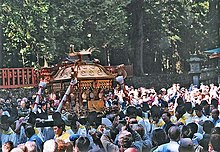
Japanese festivals are traditional festive occasions often celebrated with dance and music in Japan. Many festivals have their roots in traditional Chinese festivals, but have undergone extensive changes over time to have little resemblance to their original form, despite sharing the same name and date. There are also various local festivals that are mostly unknown outside a given prefecture.

Takayama is a city located in Gifu Prefecture, Japan. As of 1 January 2019, the city had an estimated population of 88,473 in 35,644 households, and a population density of 41 persons per km2. The total area of the city was 2,177.61 square kilometers (840.78 sq mi) making it the largest city by area in Japan. The high altitude and separation from other areas of Japan kept the area fairly isolated, allowing Takayama to develop its own culture over about a 300-year period.

A mikoshi (神輿) is a sacred religious palanquin. Shinto followers believe that it serves as the vehicle to transport a deity in Japan while moving between main shrine and temporary shrine during a festival or when moving to a new shrine. Often, the mikoshi resembles a miniature building, with pillars, walls, a roof, a veranda and a railing.

Fundoshi (ふんどし/褌) is a traditional Japanese undergarment for males and females, made from a length of cotton.

Yasaka Shrine, once called Gion Shrine, is a Shinto shrine in the Gion District of Kyoto, Japan. Situated at the east end of Shijō-dōri, the shrine includes several buildings, including gates, a main hall and a stage. The Yasaka shrine is dedicated to Susanoo in the tradition of the Gion faith as its chief kami, with his consort Kushinadahime on the east, and eight offspring deities on the west. The yahashira no mikogami include Yashimajinumi no kami, Itakeru no kami, Ōyatsuhime no kami, Tsumatsuhime no kami, Ōtoshi no kami, Ukanomitama no kami, Ōyatsuhiko no kami, and Suseribime no mikoto.

The Gion Festival is one of the largest and most famous festivals in Japan, taking place annually during the month of July in Kyoto. Many events take place in central Kyoto and at the Yasaka Shrine, the festival's patron shrine, located in Kyoto's famous Gion district, which gives the festival its name. It is formally a Shinto festival, and its original purposes were purification and pacification of disease-causing entities. There are many ceremonies held during the festival, but it is best known for its two Yamaboko Junkō (山鉾巡行) processions of floats, which take place on July 17 and 24.
Kakegoe (掛け声) usually refers to shouts and calls used in performances of traditional Japanese music, Kabuki theatre, and in martial arts such as kendo.
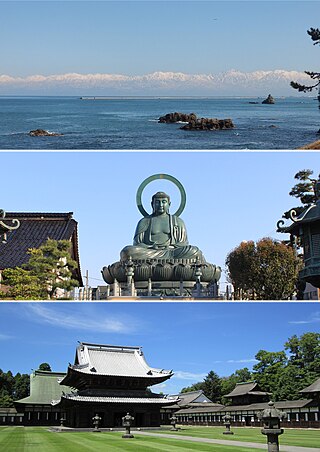
Takaoka is a city in the northwestern portion of Toyama Prefecture, Japan. Takaoka has the second largest population after Toyama City.

Danjiri Matsuri are cart-pulling festivals held in Japan. The Kishiwada Danjiri Matsuri is probably the most famous. There are other Danjiri Matsuri held in the City of Kobe and Haruki Town, but they are less popular and spectacular. The highlight of the Festival is a race between floats representing different neighborhoods.

Sanja Matsuri, or Sanja Festival, is one of the three largest Shinto festivals in Tokyo. It is considered one of the wildest and largest in Japan. The festival is held in honor of Hinokuma Hamanari, Hinokuma Takenari, and Hajino Nakatomo, the three men who established and founded the Sensō-ji Buddhist temple. Sanja Matsuri is held on the third weekend of every May at Asakusa Shrine. Its prominent parades revolve around three mikoshi, as well as traditional music and dancing. Over the course of three days, the festival attracts 1.5 to 2 million locals and tourists every year.

The Aomori Nebuta Matsuri is a Japanese summer festival that takes place in Aomori, Aomori Prefecture, Japan in early August. The festival attracts the most tourists of any of the country's nebuta festivals, and is counted among the three largest festivals in the Tōhoku region. It was designated an Important Intangible Folk Cultural Property in 1980, and as one of the 100 Soundscapes of Japan by the Ministry of the Environment in 1996.

The Takayama Festivals in Takayama in Japan started in the 16th to 17th century. The festivals are believed to have been started during the rule of the Kanamori family. Correspondence dated 1692 place the origin to 40 years prior to that date. One of the festivals is held on 14 and 15 April and the other on 9 and 10 October.
The Shinjō Matsuri (新庄まつりの山車行事) is a Japanese festival celebrated from 24 to 26 August in Shinjō, Yamagata Prefecture. Mikoshi and approximately twenty floats are drawn through the streets, accompanied by odori, drums, and other performers. It has a two hundred and fifty-year history and was designated as an Important Intangible Folk Cultural Property in 2009.
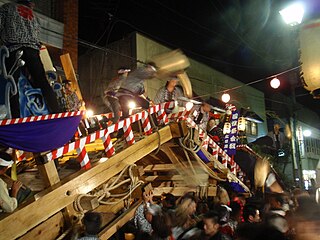
Kakunodate-matsuri (角館祭り) is a Japanese festival celebrated from 7 to 9 September in Kakunodate, Akita. Its rites centre on Shinmei-sha shrine. As well as a procession and traditional dances, it is celebrated for the oyamabayashi in which the floats collide into each other. It has a 350-year history, and in 1991 was designated an Important Intangible Folk Cultural Property.

Tsuchizaki Shinmeisha Shrine Annual Celebration And The Float Festival is a Japanese festival celebrated from 20 to 21 July in Tsuchizaki (Tsuchizakiminato), the port area of Akita City, Akita Prefecture, Japan.
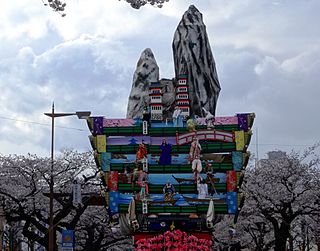
The Hitachi Furyumono (日立風流物) is a parade in Hitachi city, Japan. It is held during Hitachi Sakura Matsuri (日立さくらまつり), the annual cherry blossom festival in April, and the Great Festival at the local Kamine Shrine once in every seven years in May. It is inscribed on the UNESCO Intangible Cultural Heritage Lists as a part of "Yama, Hoko, Yatai, float festivals in Japan", 33 traditional Japan festivals.

The Kawagoe Festival, officially named the Kawagoe Hikawa Festival is a traditional Japanese festival held annually on the third weekend of October in Kawagoe City, Saitama Prefecture. It is Kawagoe's biggest event and the festival has more than a 360-year history. It attracts around one million tourists during the two days. The grand pageant of the festival takes place in the castle town of Kawagoe including in the old storehouse zone called Kurazukuri Zone.
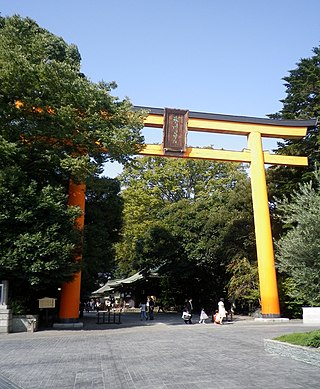
Hikawa Shrine (氷川神社) is a Shinto shrine in Kawagoe, Saitama Prefecture, Japan. In order to separate it from Hikawa Shrine in Omiya Ward, Saitama City, it is often called Kawagoe Hikawa Shrine. Hikawa Shrine is known for its Reitaisai, or a festival considered the origin of Kawagoe festival, which was registered as a National Important Intangible Folk Cultural Property and listed as a UNESCO Intangible Cultural Heritage. It's also well known for its "corridor of windchiimes".
Kumagaya Uchiwa Festival is a yearly festival that occurs in Saitama Prefecture Kumagaya city. The festival is held for five days from July 19 to 23 annually. This festival is called Uchiwa and (matsuri), because Uchiwa, the traditional Japanese fans, were distributed to people during the festival in the Meiji era.

